On n'y voit rien
25th January - 28th March 2020
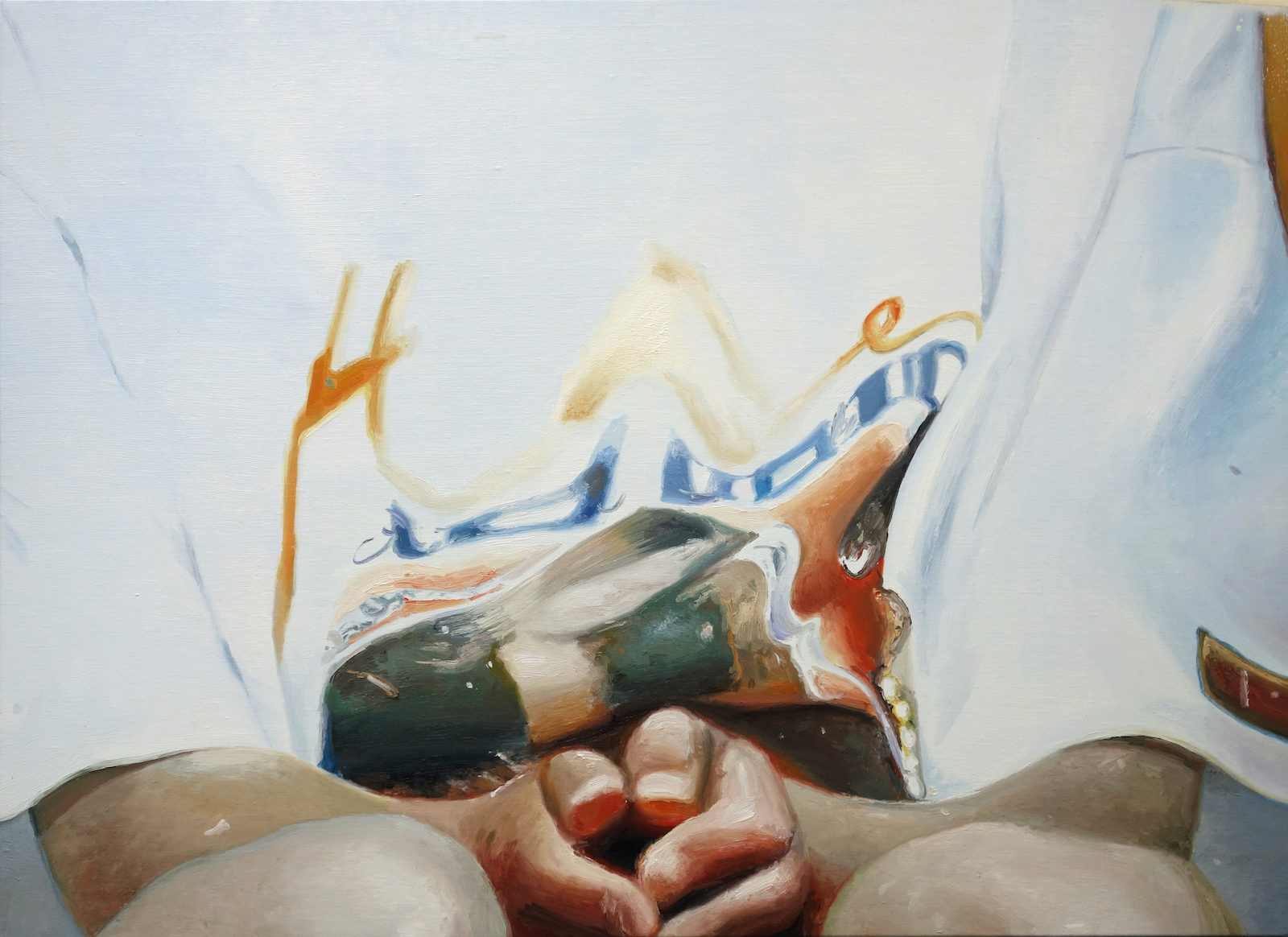
80 x 110 cm
Titled, dated, signed on the back (upper right)
Sitcom is part of a group of paintings produced from photographs of sweat-shirts. Very typical of her work, the artist transforms the picture by playing on the scale ratio to provide a different angle. By the inclination of the focal length towards a close perspective and by enlarging the picture, Mireille Blanc subtly fades the subject out of the image, and constructs a filter between the artwork and the one who is looking at it. By blurring the inscription and the image's context, often old-fashion and kitsch, she focuses on the vagueness of the elements treated and plays on the enigmatic nature of subjects she encounters.
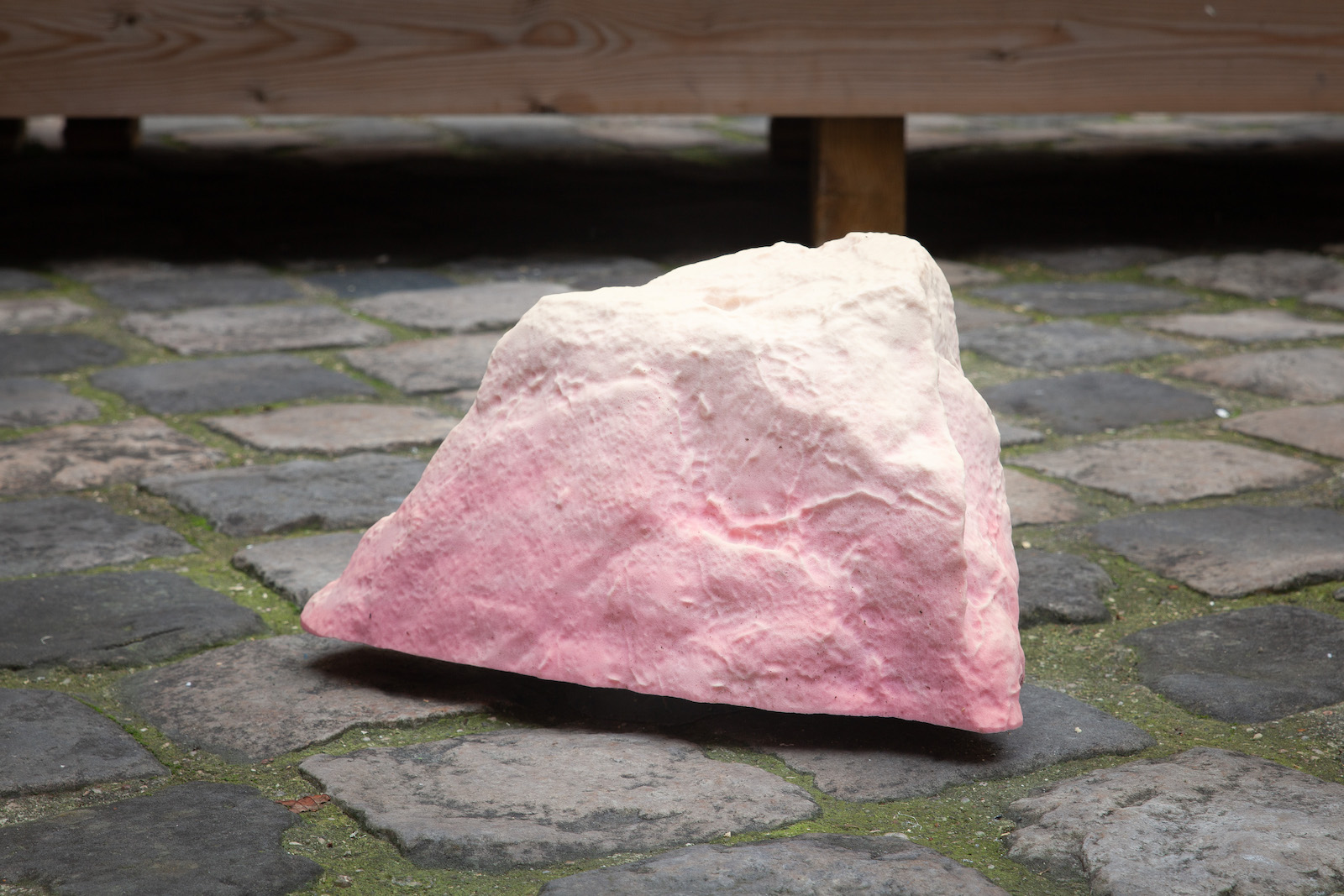
23 x 40 x 24 cm
The Mitate sculptures have been initially produced for an installation named L'oubli des formes, l'empreinte demeure. The latter took a direct inspiration from Japanese garden Art, and more precisely from Zen gardens. Julien Discrit uses the principle of standing stones visible from a slightly elevated position, typical of Zen meditation.
While this project does not pretend to faithfully recreate Japanese temple, the colorized monoliths are reproductions of rocks composing the Komyo-in, a Buddhist temple located in Kyoto. The artist made 3D scan of the stones which, by a work of machining and moulding with resin, can find a form of iteration. If the forms have been moved from Japan to Paris, the graphical aspect of these stones become sculptures is the result of a research on flow, fluid and marbling.
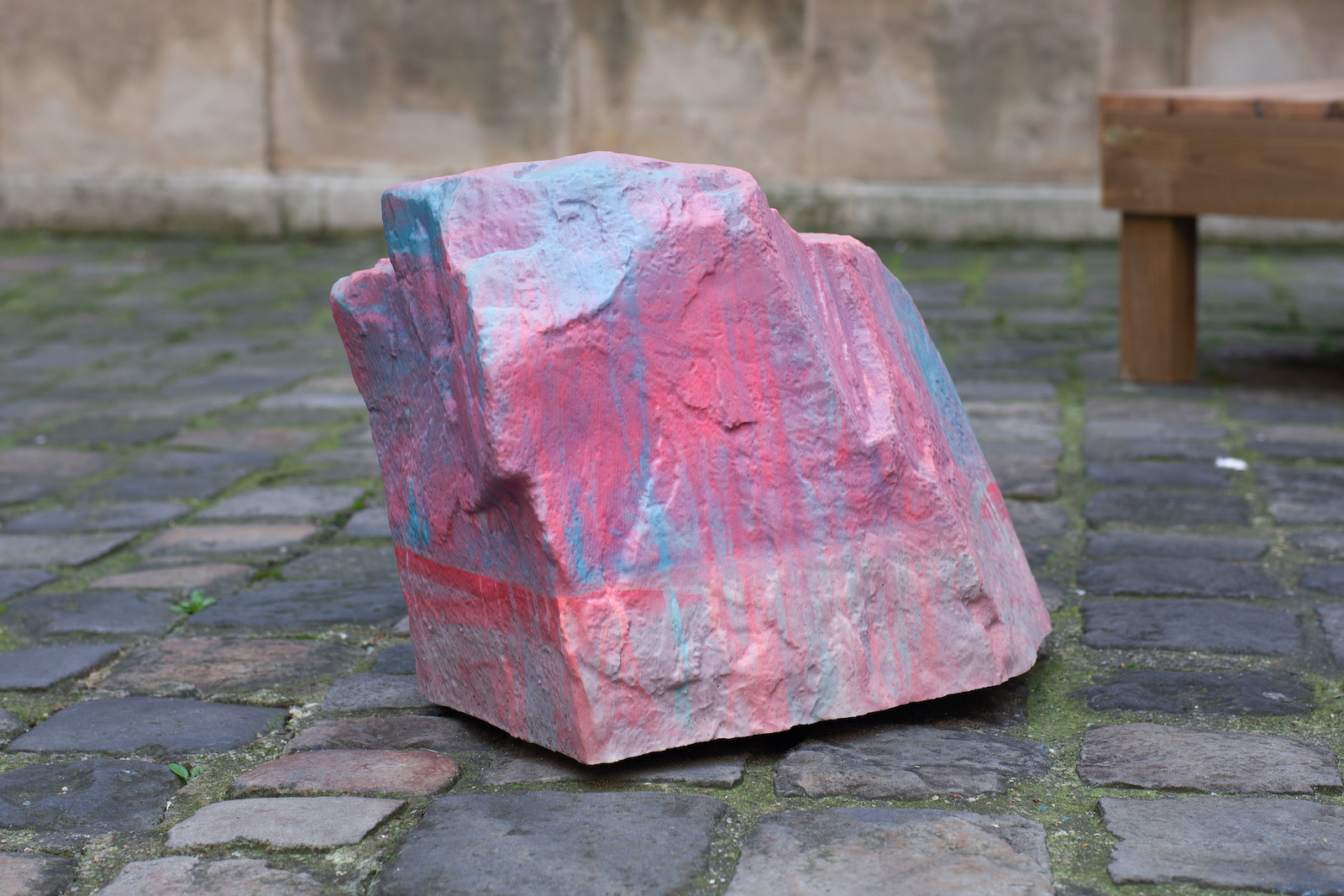
39,5 x 60 x 40 cm
The Mitate sculptures have been initially produced for an installation named L'oubli des formes, l'empreinte demeure. The latter took a direct inspiration from Japanese garden Art, and more precisely from Zen gardens. Julien Discrit uses the principle of standing stones visible from a slightly elevated position, typical of Zen meditation.
While this project does not pretend to faithfully recreate Japanese temple, the colorized monoliths are reproductions of rocks composing the Komyo-in, a Buddhist temple located in Kyoto. The artist made 3D scan of the stones which, by a work of machining and moulding with resin, can find a form of iteration. If the forms have been moved from Japan to Paris, the graphical aspect of these stones become sculptures is the result of a research on flow, fluid and marbling.
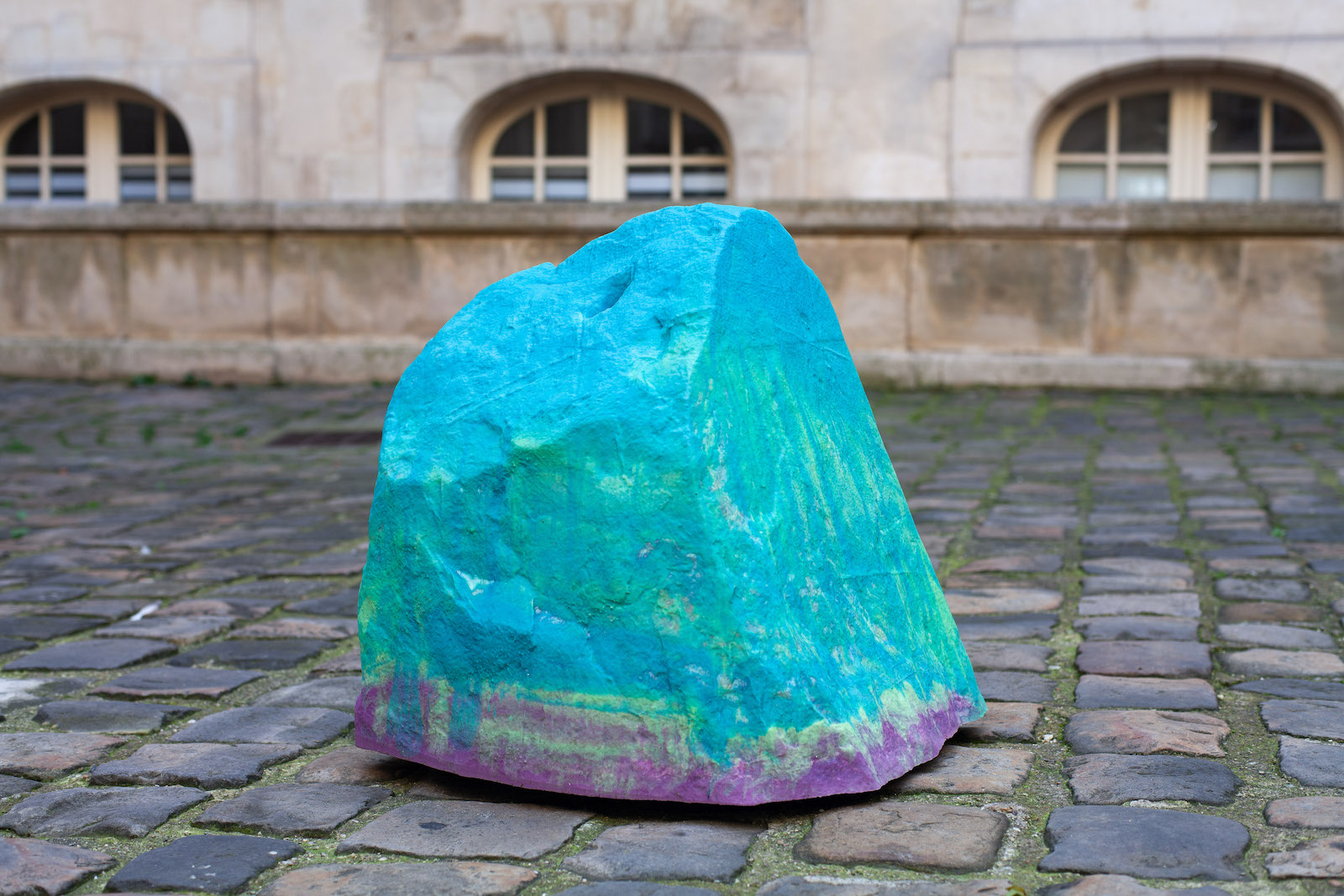
61,5 x 84 x 59 cm
The Mitate sculptures have been initially produced for an installation named L'oubli des formes, l'empreinte demeure. The latter took a direct inspiration from Japanese garden Art, and more precisely from Zen gardens. Julien Discrit uses the principle of standing stones visible from a slightly elevated position, typical of Zen meditation.
While this project does not pretend to faithfully recreate Japanese temple, the colorized monoliths are reproductions of rocks composing the Komyo-in, a Buddhist temple located in Kyoto. The artist made 3D scan of the stones which, by a work of machining and moulding with resin, can find a form of iteration. If the forms have been moved from Japan to Paris, the graphical aspect of these stones become sculptures is the result of a research on flow, fluid and marbling.
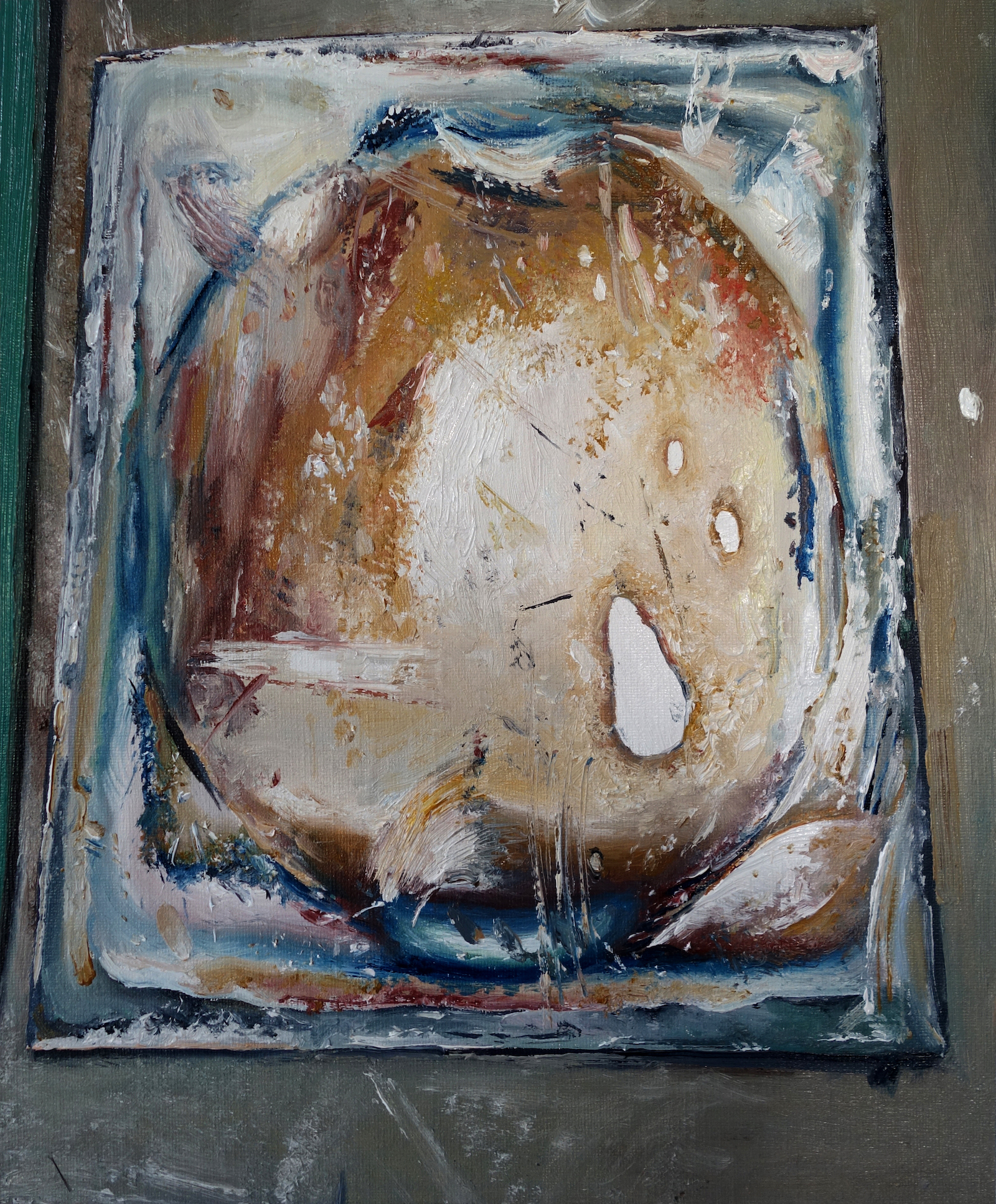
33 x 27 cm
Titled, dated, signed on the back (upper right)
Daguerréotype (1) is an artwork created from former original daguerreotype coming from Emmanuelle Fructus' collection. Here, the artist focuses on the ghostly nature of past images, formerly contained on copper plates represented on these paintings. Very typical of the artist's work, these paintings show her willingness to entail the abstract nature of the subject during the image transformation and creation.
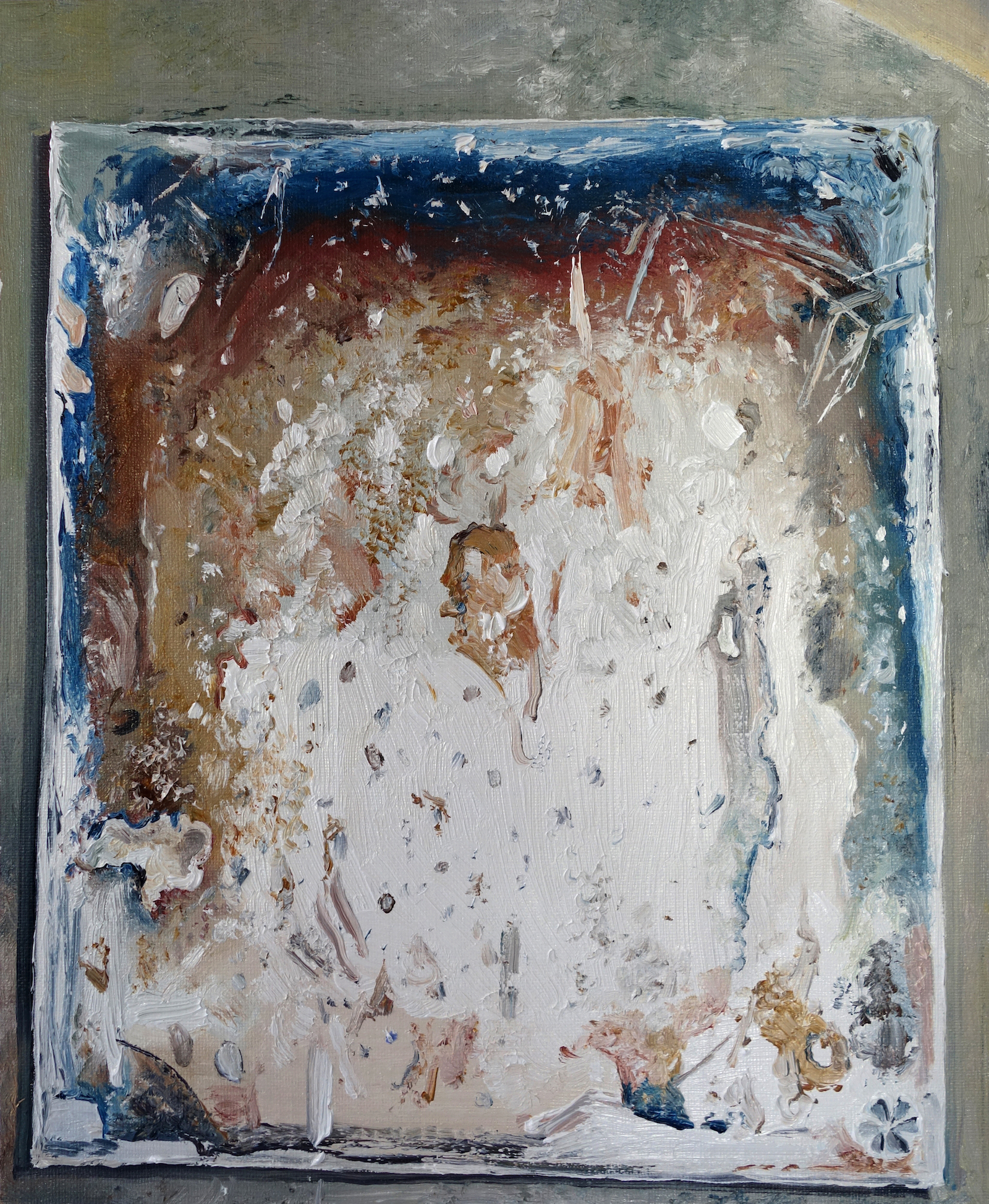
33 x 27 cm
Titled, dated, signed on the back (upper right)
Daguerréotype (2) is an artwork created from former original daguerreotype coming from Emmanuelle Fructus' collection. Here, the artist focuses on the ghostly nature of past images, formerly contained on copper plates represented on these paintings. Very typical of the artist's work, these paintings show her willingness to entail the abstract nature of the subject during the image transformation and creation.
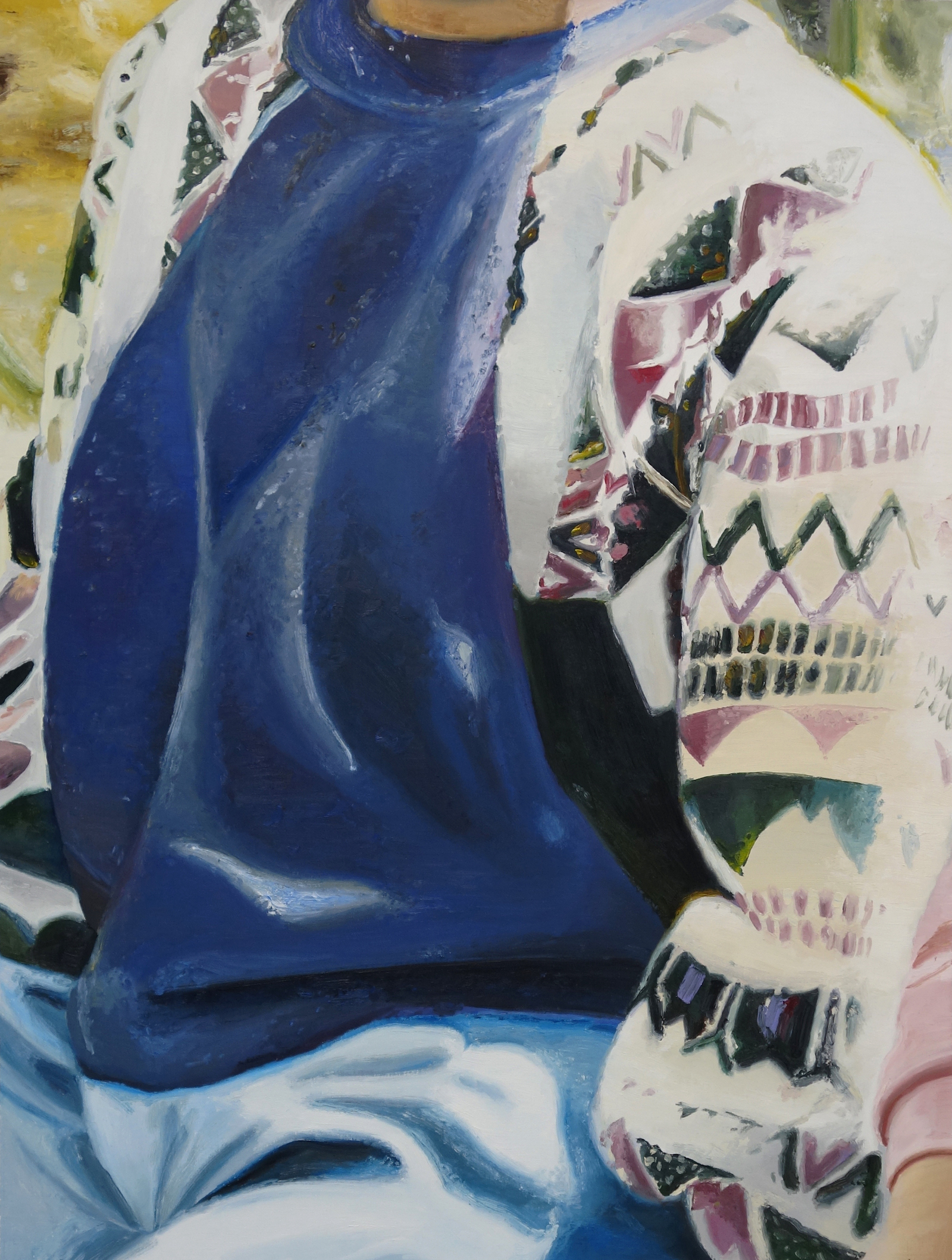
120 x 90 cm
Titled, dated, signed on the back (upper right)
Petit sweat bleu is part of a group of paintings produced from photographs of sweat-shirts. Very typical of her work, the artist transforms the picture by playing on the scale ratio to provide a different angle. By the inclination of the focal length towards a close perspective and by enlarging the picture, Mireille Blanc subtly fades the subject out of the image, and constructs a filter between the artwork and the one who is looking at it. By blurring the inscription and the image's context, often old-fashion and kitsch, she focuses on the vagueness of the elements treated and plays on the enigmatic nature of subjects she encounters.
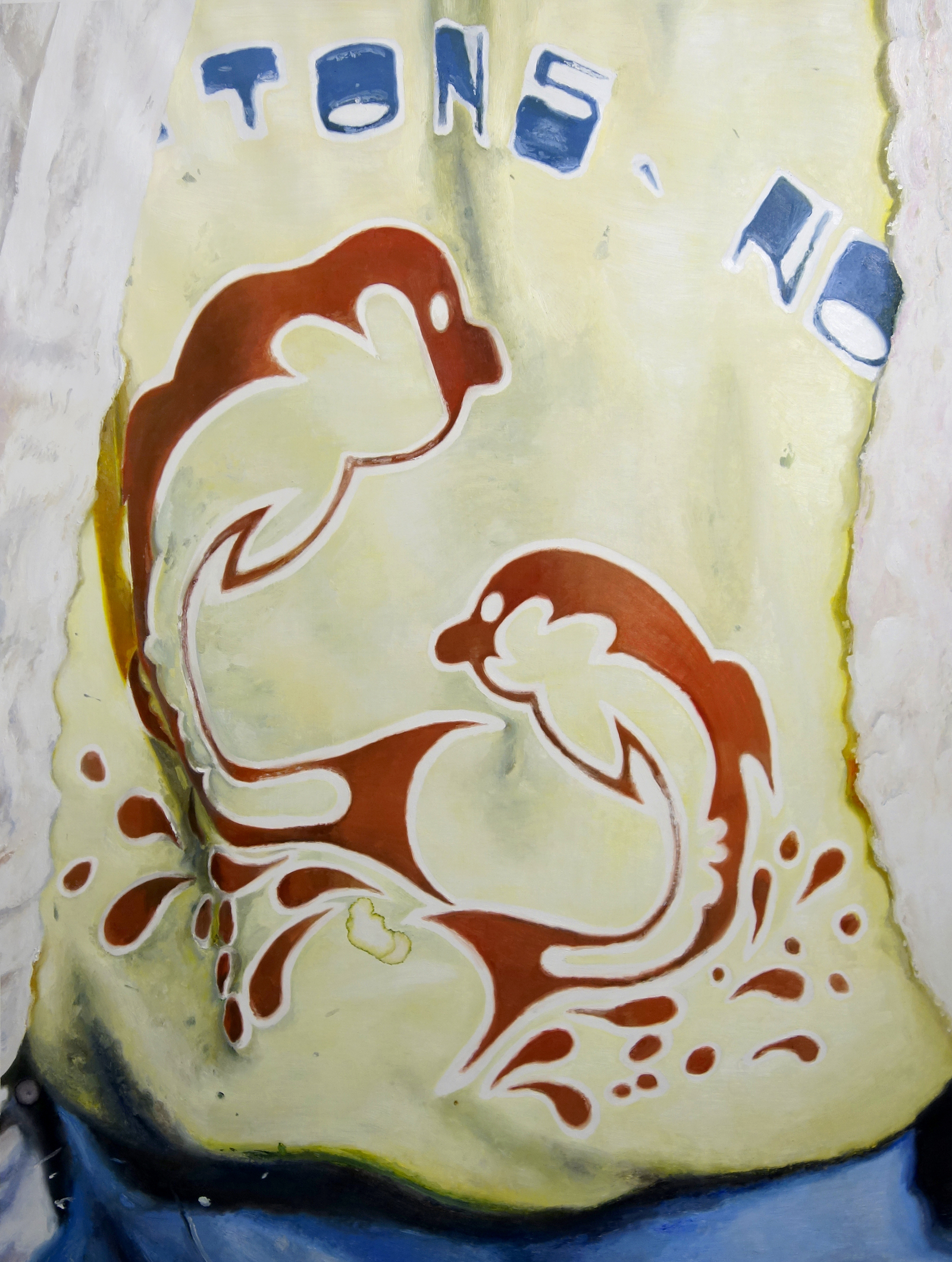
200 x 150 cm
Titled, dated, signed on the back (upper right)
Sweat (Dauphins) is part of a group of paintings produced from photographs of sweat-shirts. Very typical of her work, the artist transforms the picture by playing on the scale ratio to provide a different angle. By the inclination of the focal length towards a close perspective and by enlarging the picture, Mireille Blanc subtly fades the subject out of the image, and constructs a filter between the artwork and the one who is looking at it. By blurring the inscription and the image's context, often old-fashion and kitsch, she focuses on the vagueness of the elements treated and plays on the enigmatic nature of subjects she encounters.
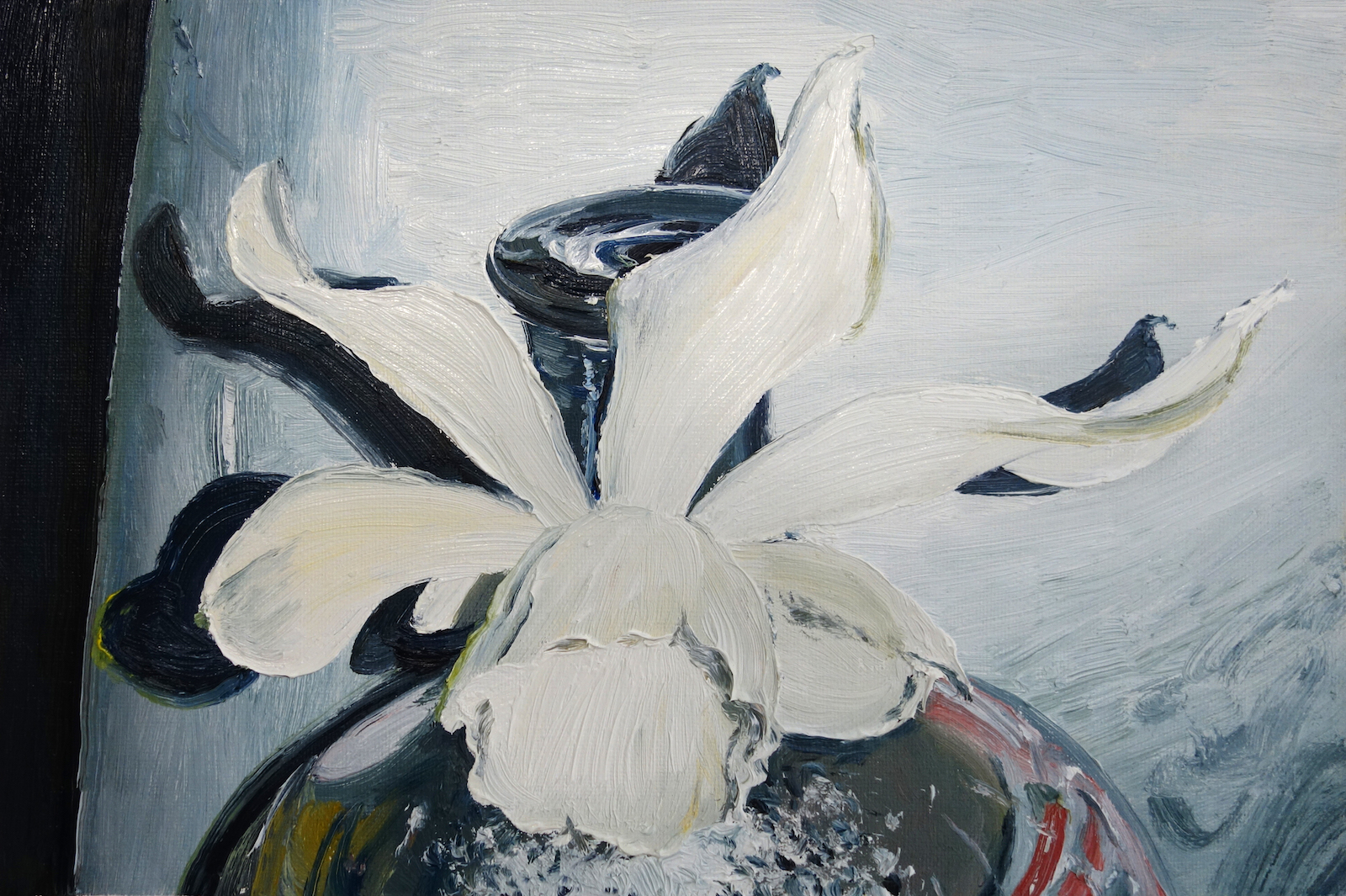
20 x 30 cm
Titled, dated, signed on the back (upper right)
In Jonquille (2), Mireille Blanc explores the relation with reflection and materials penetration. To this end, she started from a photograph of a daffodil in a vase, located in front of an absorbent towel roll. By transforming the picture and playing on scale ratio, she focuses on the relation between the roll and the coloured vase, to lose the viewer in the image and blur the context. This artwork is a variation of Jonquille, with a different focus which reinforces even more the abstraction of the subject.
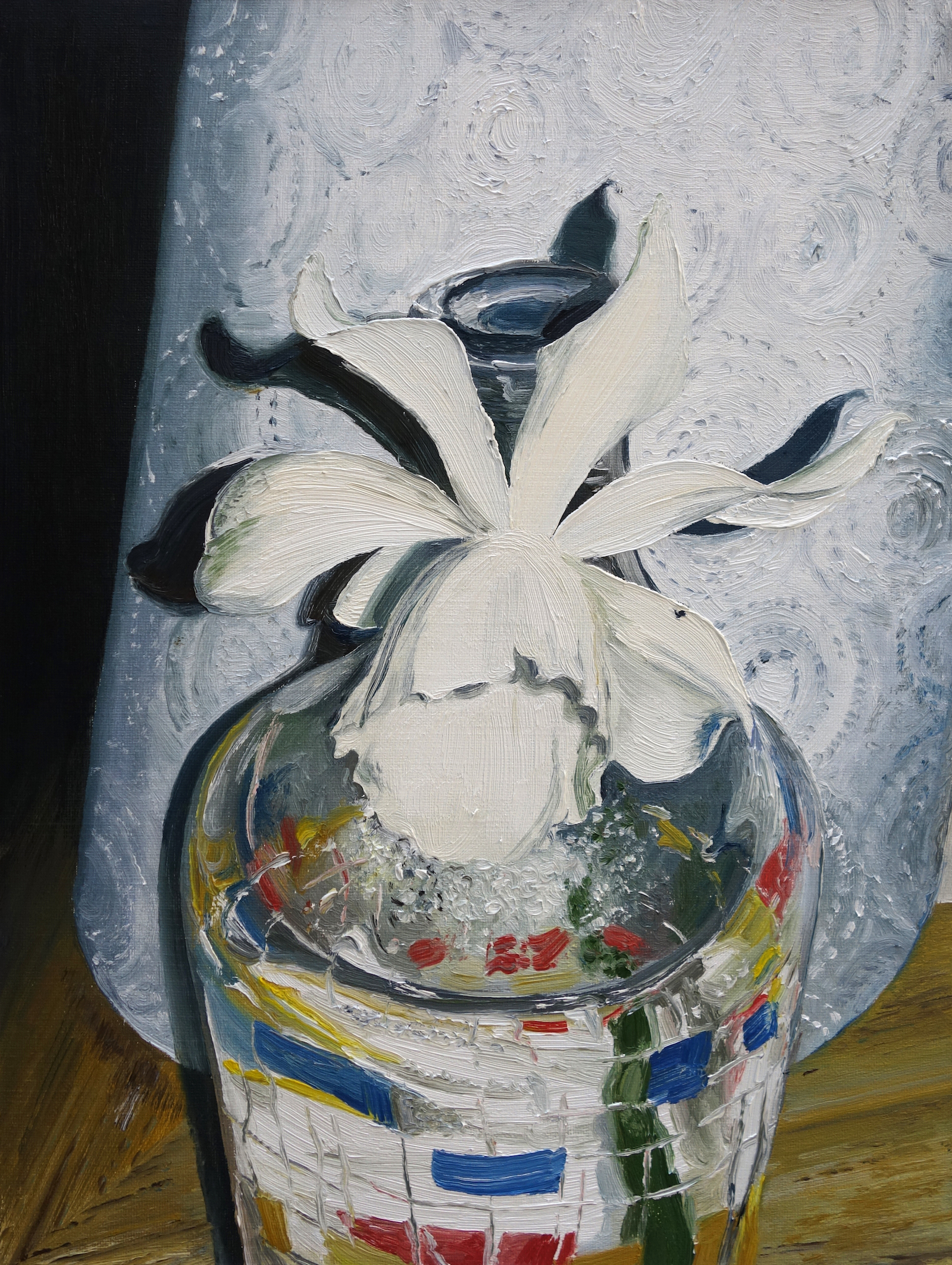
40 x 30 cm
Titled, dated, signed on the back (upper right)
In Jonquille, Mireille Blanc explores the relation with reflection and materials penetration. To this end, she started from a photograph of a daffodil in a vase, located in front of an absorbent towel roll. By transforming the picture and playing on scale ratio, she focuses on the relation between the roll and the coloured vase, to lose the viewer in the image and blur the context.
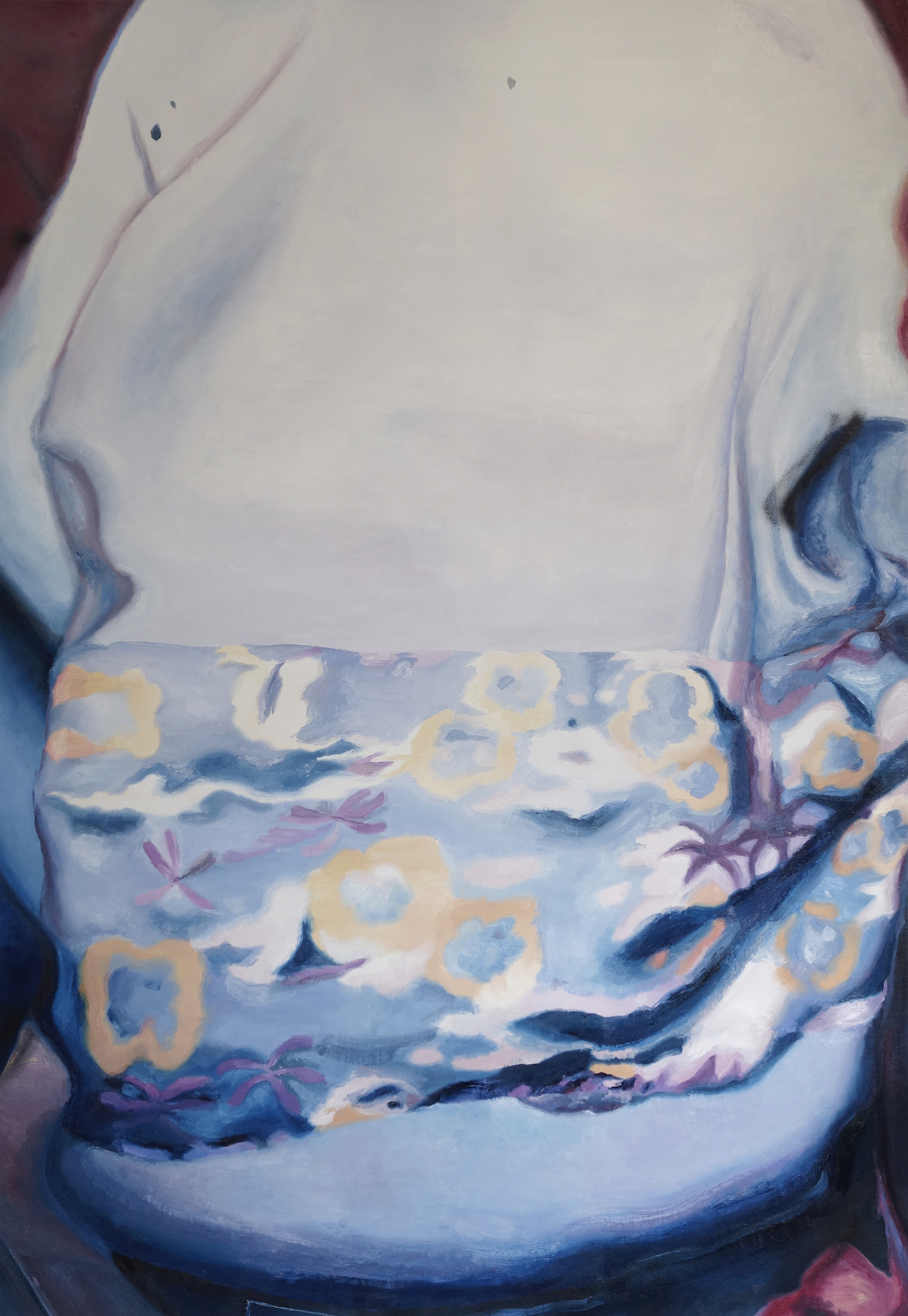
180 x 124 cm
Titled, dated, signed on the back (upper right)
Motif is part of a group of paintings produced from photographs of sweat-shirts. Very typical of her work, the artist transforms the picture by playing on the scale ratio to provide a different angle. By the inclination of the focal length towards a close perspective and by enlarging the picture, Mireille Blanc subtly fades the subject out of the image, and constructs a filter between the artwork and the one who is looking at it. By blurring the inscription and the image's context, often old-fashion and kitsch, she focuses on the vagueness of the elements treated and plays on the enigmatic nature of subjects she encounters.
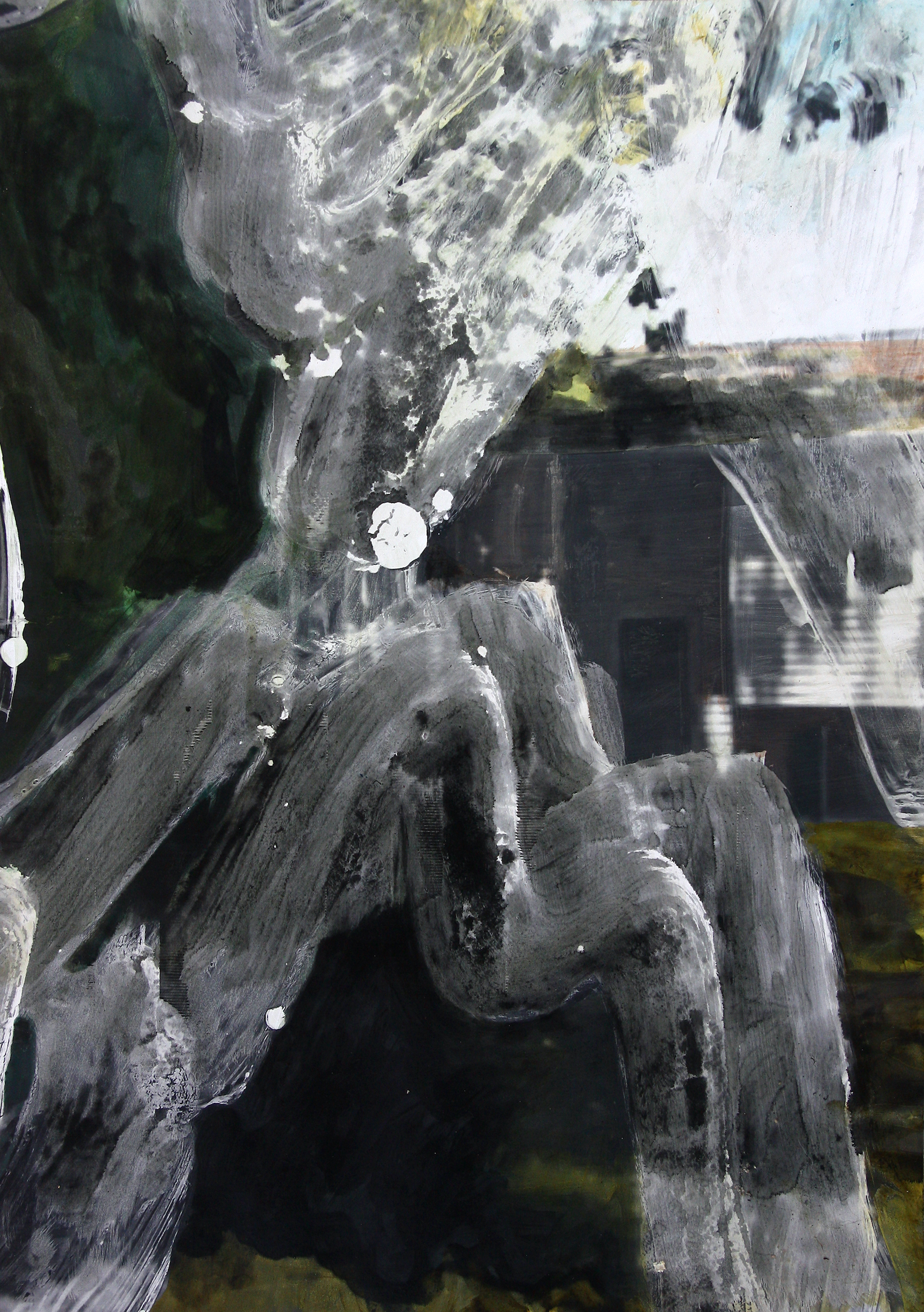
watercolor, ink, acrylic, print on paper
58 x 41 cm
Dans la lignée de son travail sur la recherche d'horizon et de pénétration du paysage, Eva Nielsen a produit la série Aklat spécialement pour l'exposition en explorant un geste nouveau qui compose toute la singularité de ces oeuvres.
Cette série tire son nom d'un dialecte philippin, et signifie « feuillets réunis ensemble ». En assemblant différentes strates d'impression et de dessin (à l'encre, acrylique et aquarelle) l'artiste renverse ainsi le geste traditionnel et crée un trompe l'oeil qui s'interpose entre l'image et le spectateur. Ce dispositif vient heurter l'apparence du pinceau, de telle sorte que les techniques se confondent et s'inversent dans la perception du regardeur entre ce qui relève de l'impression ou du travail manuel de l'artiste. Ce jeu conceptuel d'agencement de puzzle de strates retranscrit notamment les enjeux historiques et politiques liés à l'architecture des habitations périurbaines représentés sur l'image. Mais au-delà, le procédé artistique se métaphorise avec son sujet pour souligner la poésie triviale de notre environnement.
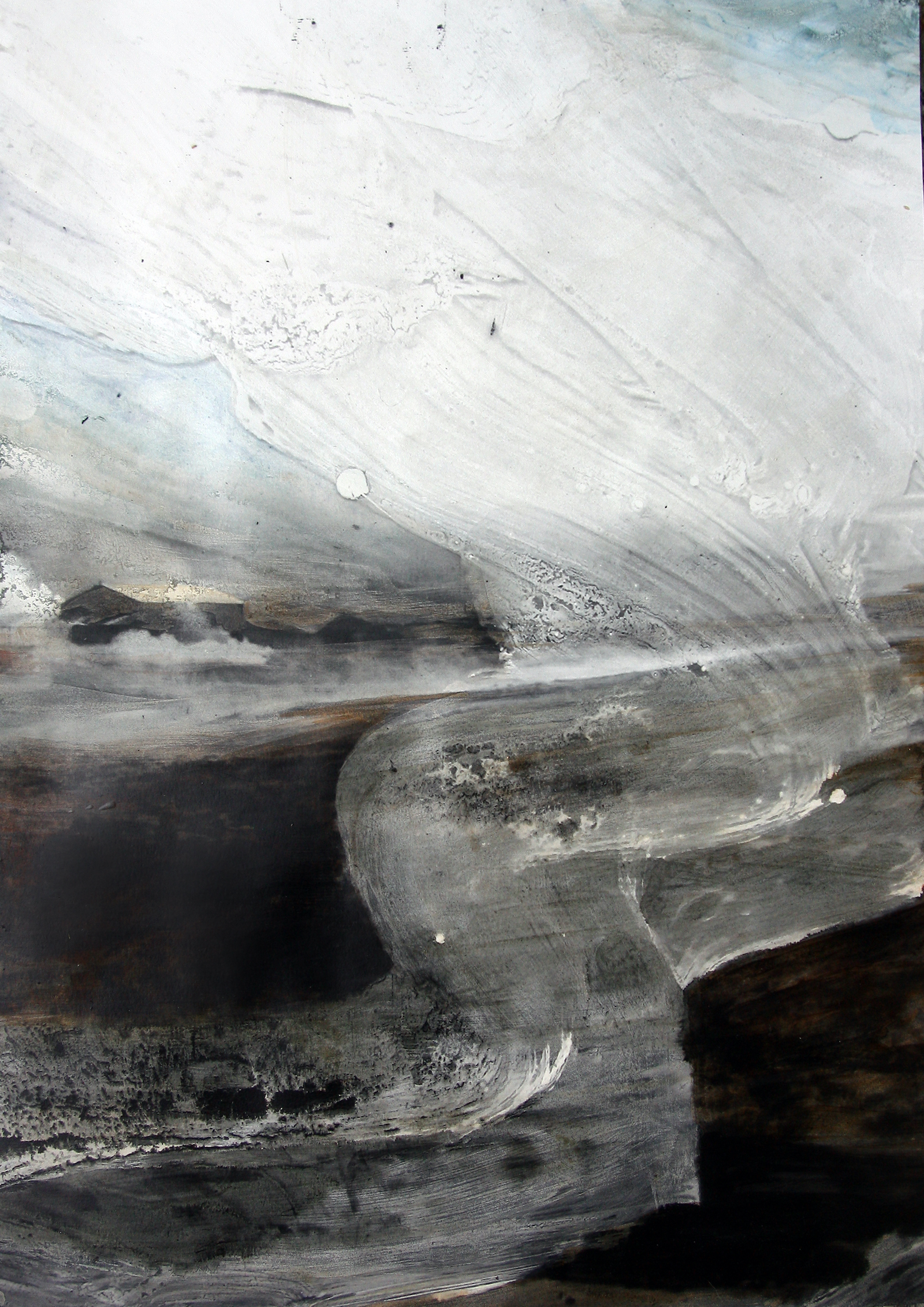
watercolor, ink, acrylic, print on paper
58 x 41 cm
Dans la lignée de son travail sur la recherche d’horizon et de pénétration du paysage, Eva Nielsen a produit la série Aklat spécialement pour l’exposition en explorant un geste nouveau qui compose toute la singularité de ces œuvres.
Cette série tire son nom d’un dialecte philippin, et signifie « feuillets réunis ensemble ». En assemblant différentes strates d’impression et de dessin (à l’encre, acrylique et aquarelle) l’artiste renverse ainsi le geste traditionnel et crée un trompe l’œil qui s’interpose entre l’image et le spectateur. Ce dispositif vient heurter l’apparence du pinceau, de telle sorte que les techniques se confondent et s’inversent dans la perception du regardeur entre ce qui relève de l’impression ou du travail manuel de l'artiste. Ce jeu conceptuel d’agencement de puzzle de strates retranscrit notamment les enjeux historiques et politiques liés à l’architecture des habitations périurbaines représentés sur l’image. Mais au-delà, le procédé artistique se métaphorise avec son sujet pour souligner la poésie triviale de notre environnement.
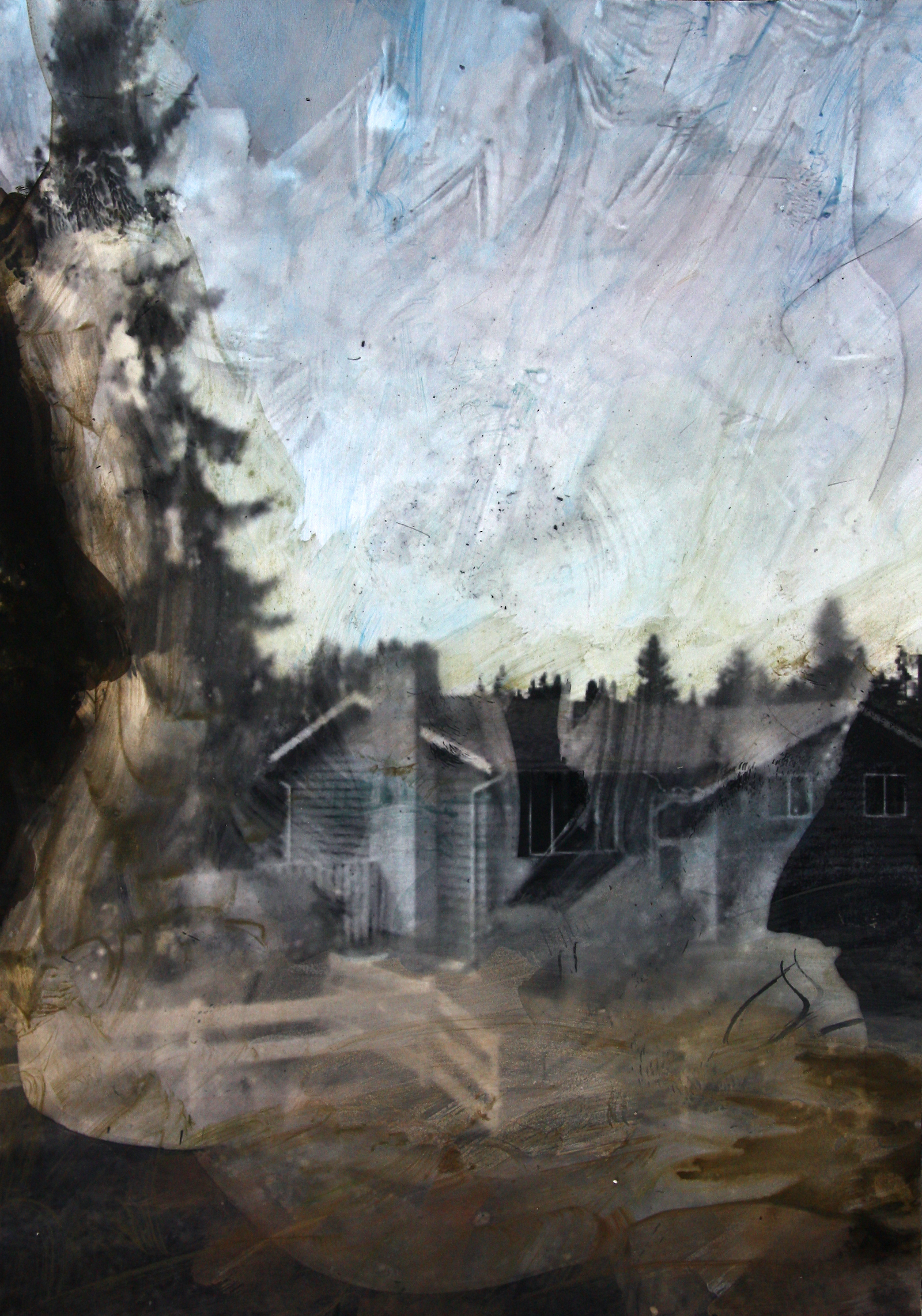
watercolor, ink, acrylic, print on paper
58 x 41 cm
Dans la lignée de son travail sur la recherche d'horizon et de pénétration du paysage, Eva Nielsen a produit la série Aklat spécialement pour l'exposition en explorant un geste nouveau qui compose toute la singularité de ces oeuvres.
Cette série tire son nom d'un dialecte philippin, et signifie « feuillets réunis ensemble ». En assemblant différentes strates d'impression et de dessin (à l'encre, acrylique et aquarelle) l'artiste renverse ainsi le geste traditionnel et crée un trompe l'oeil qui s'interpose entre l'image et le spectateur. Ce dispositif vient heurter l'apparence du pinceau, de telle sorte que les techniques se confondent et s'inversent dans la perception du regardeur entre ce qui relève de l'impression ou du travail manuel de l'artiste. Ce jeu conceptuel d'agencement de puzzle de strates retranscrit notamment les enjeux historiques et politiques liés à l'architecture des habitations périurbaines représentés sur l'image. Mais au-delà, le procédé artistique se métaphorise avec son sujet pour souligner la poésie triviale de notre environnement.
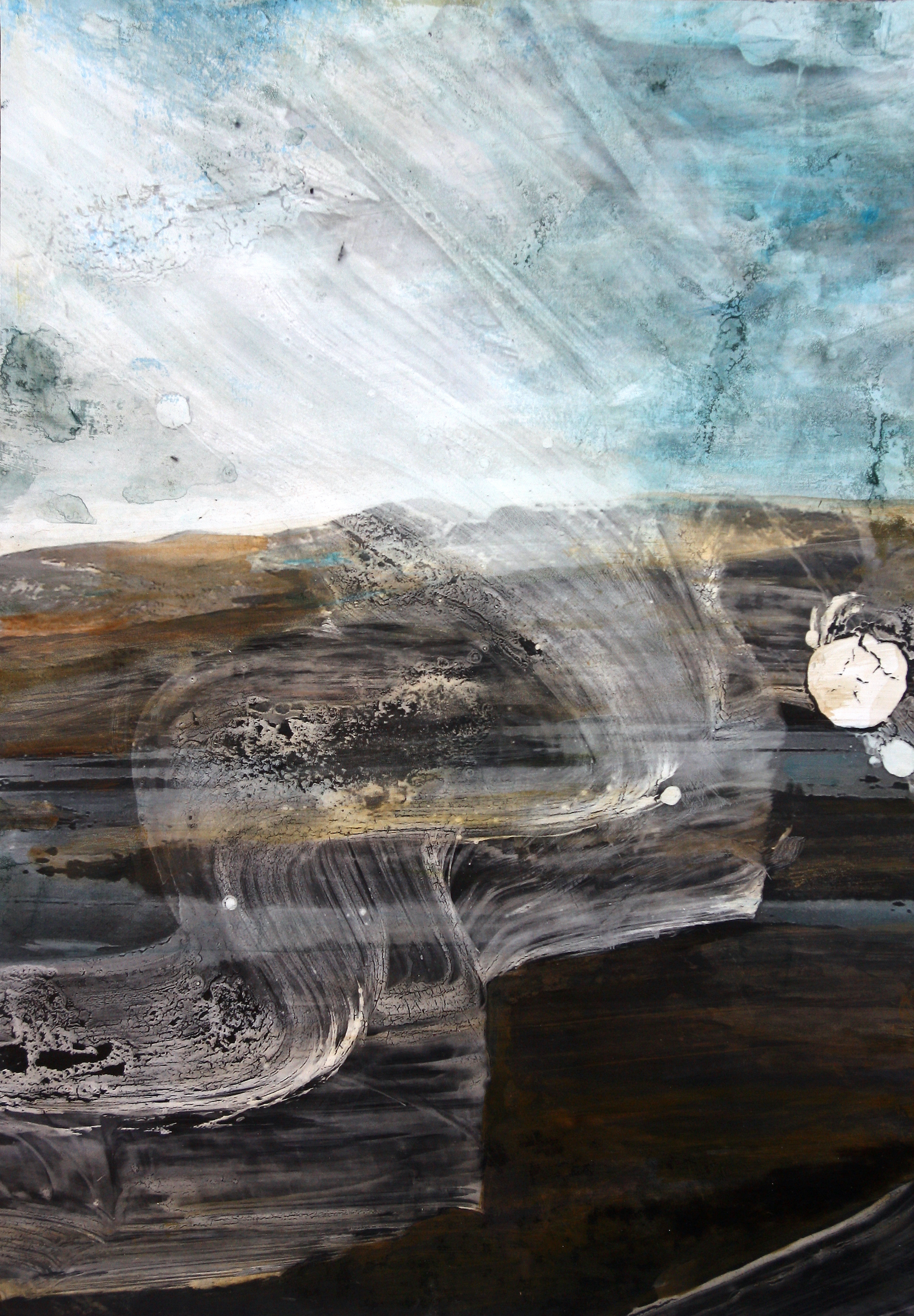
watercolor, ink, acrylic, print on paper
58 x 41 cm
Dans la lignée de son travail sur la recherche d'horizon et de pénétration du paysage, Eva Nielsen a produit la série Aklat spécialement pour l'exposition en explorant un geste nouveau qui compose toute la singularité de ces œuvres.
Cette série tire son nom d'un dialecte philippin, et signifie « feuillets réunis ensemble ». En assemblant différentes strates d'impression et de dessin (à l'encre, acrylique et aquarelle) l'artiste renverse ainsi le geste traditionnel et crée un trompe l'œil qui s'interpose entre l'image et le spectateur. Ce dispositif vient heurter l'apparence du pinceau, de telle sorte que les techniques se confondent et s'inversent dans la perception du regardeur entre ce qui relève de l'impression ou du travail manuel de l'artiste. Ce jeu conceptuel d'agencement de puzzle de strates retranscrit notamment les enjeux historiques et politiques liés à l'architecture des habitations périurbaines représentés sur l'image. Mais au-delà, le procédé artistique se métaphorise avec son sujet pour souligner la poésie triviale de notre environnement.
Exposition:
- On n'y voit rien, Galerie Anne-Sarah Bénichou, Paris, France, 2020
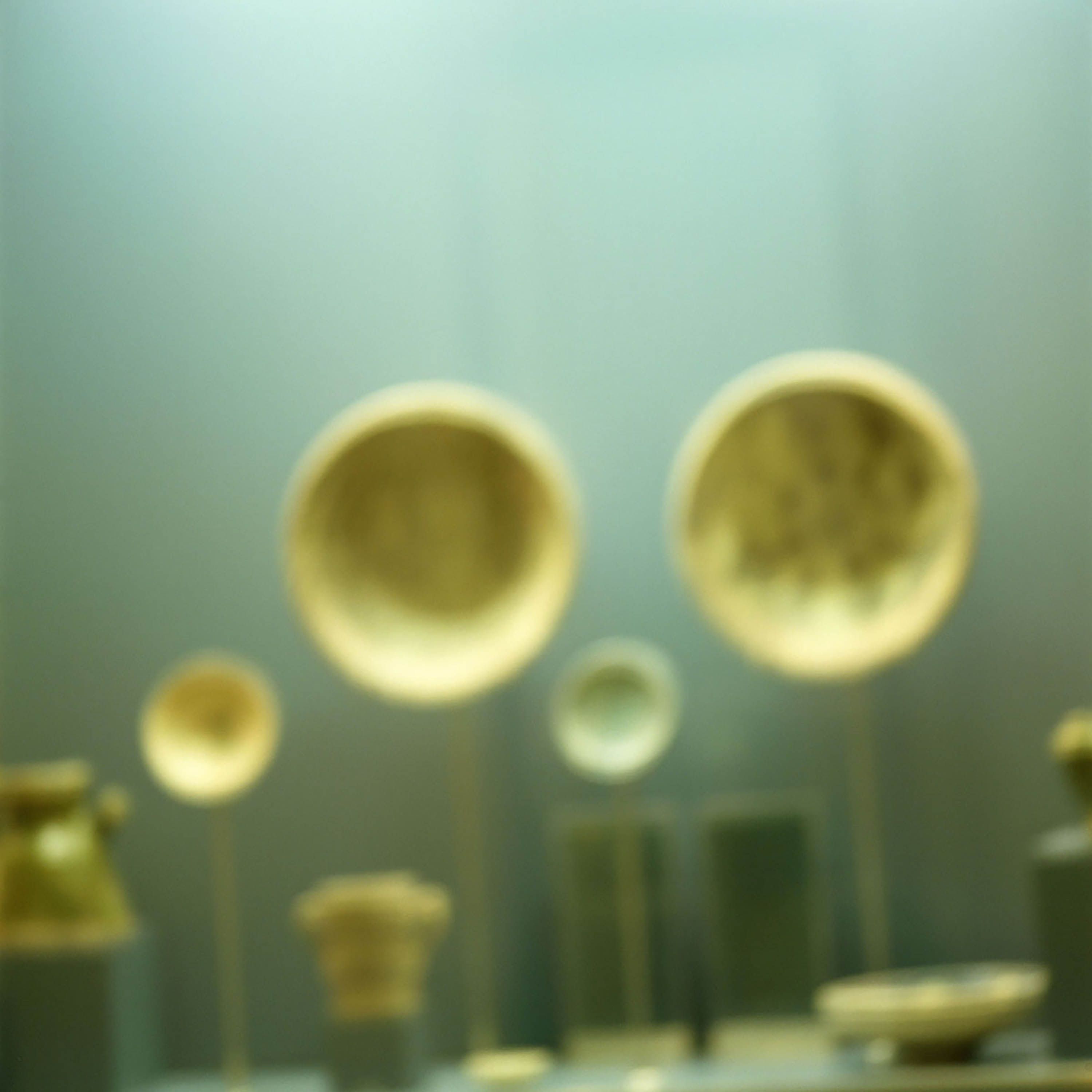
Image: 23,6 x 23,6 inches
Paper: 23,6 x 23,6 inches
Seton Smith has taken many photographs of museum interiors. In Blue Ground With Stone, it is archaeological elements located in Italy that interest the artist. This piece of art is typical of her work and takes the opposite stance of museum photographs traditionally focused on the promotion of artworks. Manipulating blurring focus and close perspective, the artist produces an image close to a monochrome which dismantles customary structures. We cannot embrace what is pictured and the artwork’s main stake is not the object in itself but the sentiment extracted from its shot. She confronts the viewer to its own representation and questions the notion of space and artwork integrated in the museum.
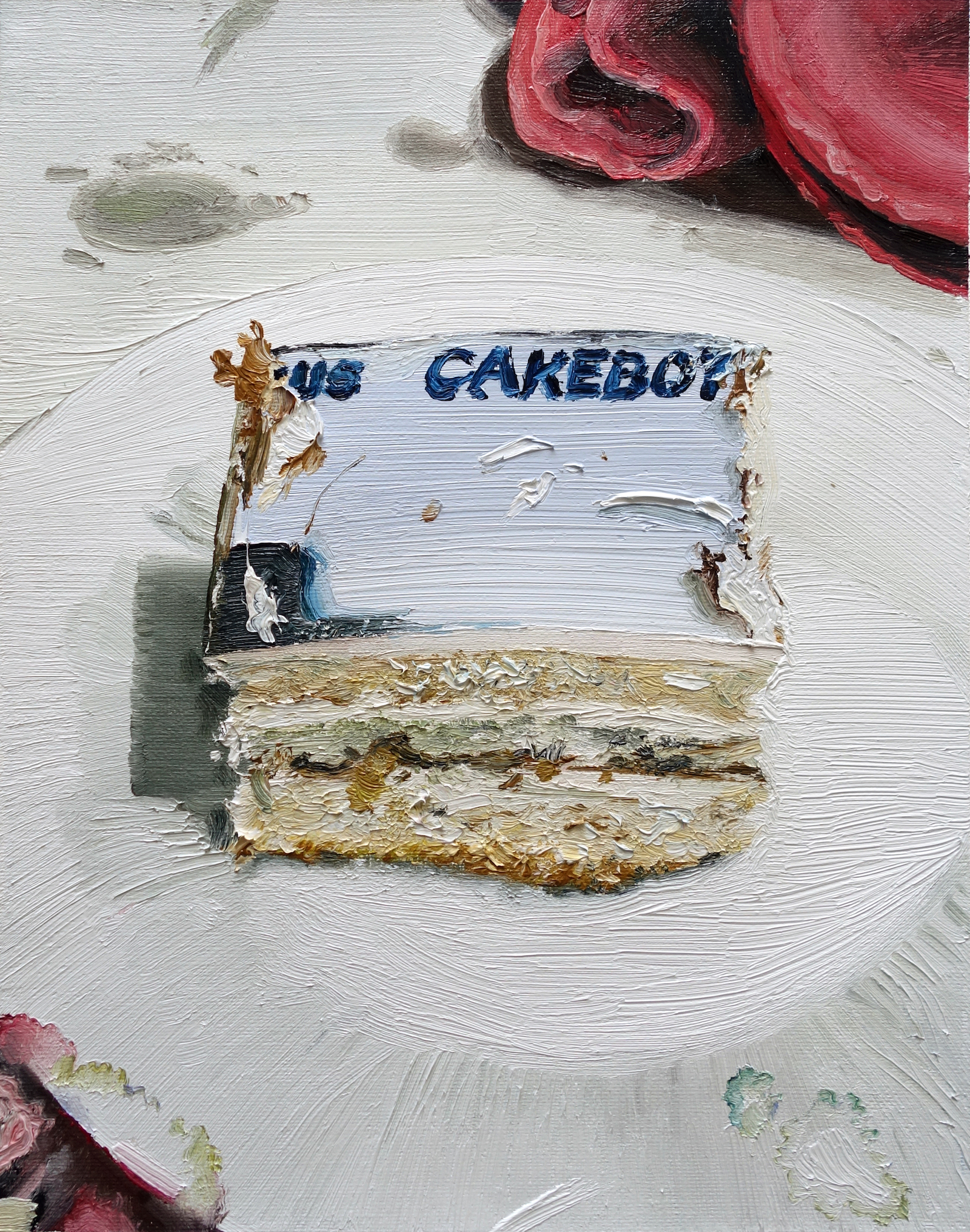
27 x 21 cm
Titled, dated, signed on the back (upper right)
Cakeboy is a painting produced from a photograph captured during a child birthday party. As usual in Mireille Blanc's work, the subject imposes itself with a relation of attraction/revulsion inherent to the instinctive nature of her work. The details manipulated in the painting represent studio's accidents during the photograph's development such as the water spots on the canvas. This work on details aims to lose the viewer and blur the artwork's context to constitutes a new reality linked to the image construction.
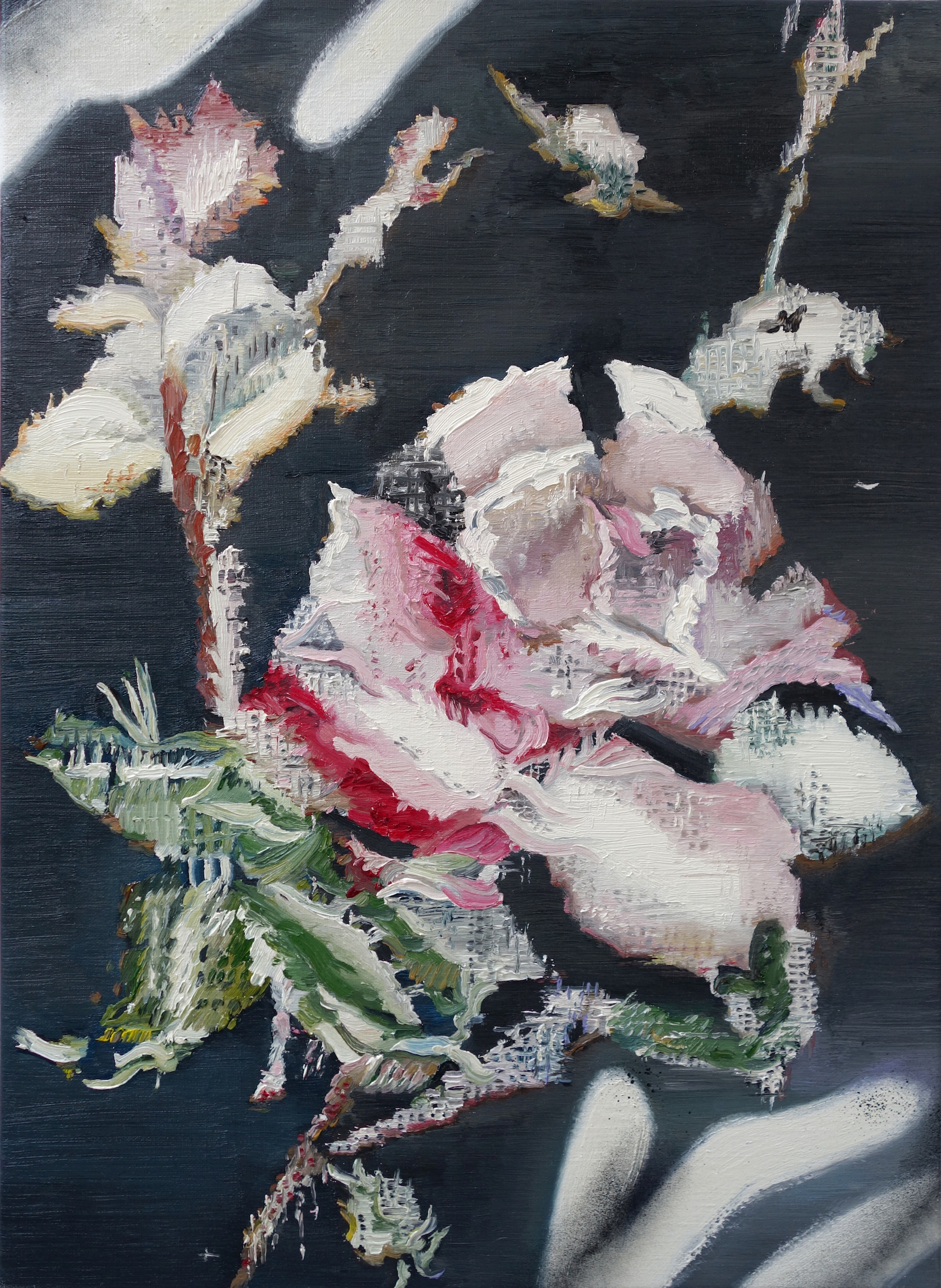
23,6 x 17,3 in.
Titled, dated, signed on the back (upper right)
In Fleur 1, Mireille Blanc expresses a particular interest in the flower pattern and transforms it in an indirect manner. From the back of canvas representing a rose, she skews all the more the image, and highlights this work of transformations in her painting. In this way, the artist conceives an artwork pointing a new reality, with the presence of black and white traces which blur the primary subject.
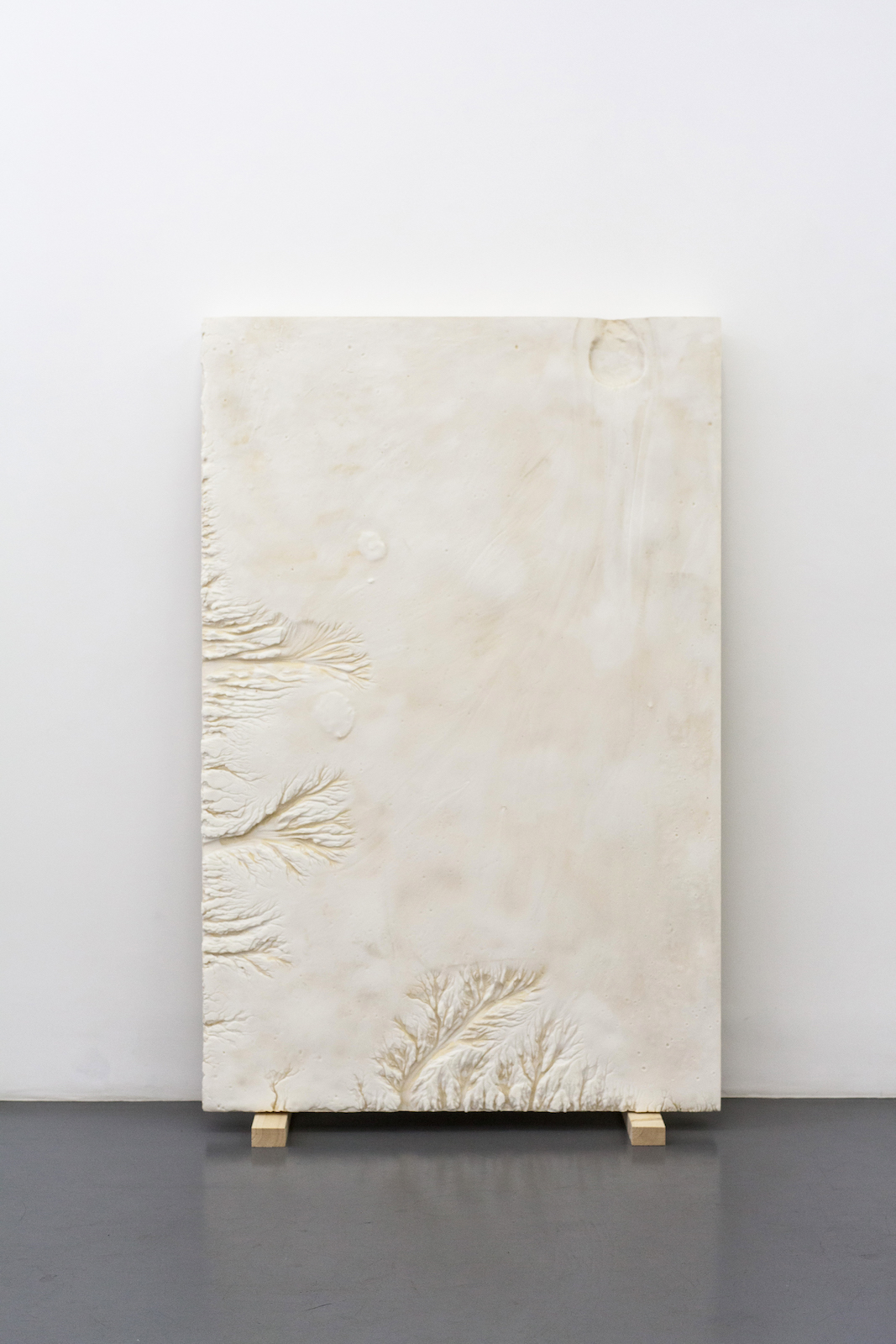
Résine polyuréthane, mousse P.U, Peinture acrylique
57 x 31 x 3,3 inch
This resin casting is the result of the slow pouring of water through a bed of silica and present the frozen image of a liquid continuum. The subtle forms as much as the traced lines seem to be the emanation of an intelligence of water, a deep network of neurons, a self-generated sculpture which responds to it own logic. Equally taking interest in the miniature and the maquette, this work pursues research initiated in older works such as États Inversées (Inverted States) or Inframince Mont-Blanc (Mont-Blanc Infrathin).